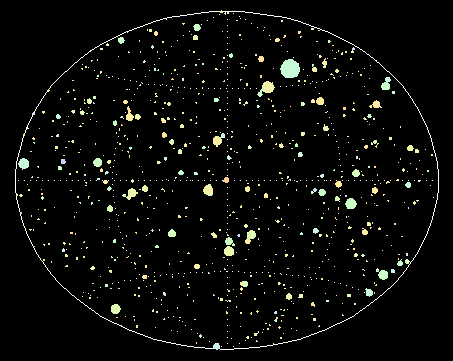
|
Explanation: Gamma Ray Bursts (GRBs) pose one of the greatest mysteries of modern astronomy. About once a day, the gamma-ray sky lights up with a spectacular explosion. No one knows what causes these explosions or even how far away they are. The above map represents the entire sky in coordinates centered on our Galaxy, the Milky Way. It shows the positions of over 800 of these mysterious bursts of energy detected by the BATSE instrument on board NASA's Compton Gamma Ray Observatory. Before BATSE, most astronomers thought that most GRBs occurred in the disk of our Galaxy, but the above sky map shows little sign of this. The distance scale of GRBs was the topic of a historic debate in April 1995. The positions in the above map are currently being studied in great detail in an effort to uncover a clue about the nature of GRBs.
In the above 3B map created by Robert Nemiroff, spot size is proportional to peak flux and spot color is indicative of hardness. Click here for a postscript version of BATSE's latest map of 1122 GRB locations (3B Catalog).
Tomorrow's picture: Dusty Galaxy Centaurus A
|
January February March April May June July August September October November December |
| ||||||||||||||||||||||||||||||||||||||||||||||||
NASA Web Site Statements, Warnings, and Disclaimers
NASA Official: Jay Norris. Specific rights apply.
A service of: LHEA at NASA / GSFC
& Michigan Tech. U.
Based on Astronomy Picture
Of the Day
Publications with keywords: gamma ray
Publications with words: gamma ray
See also:
